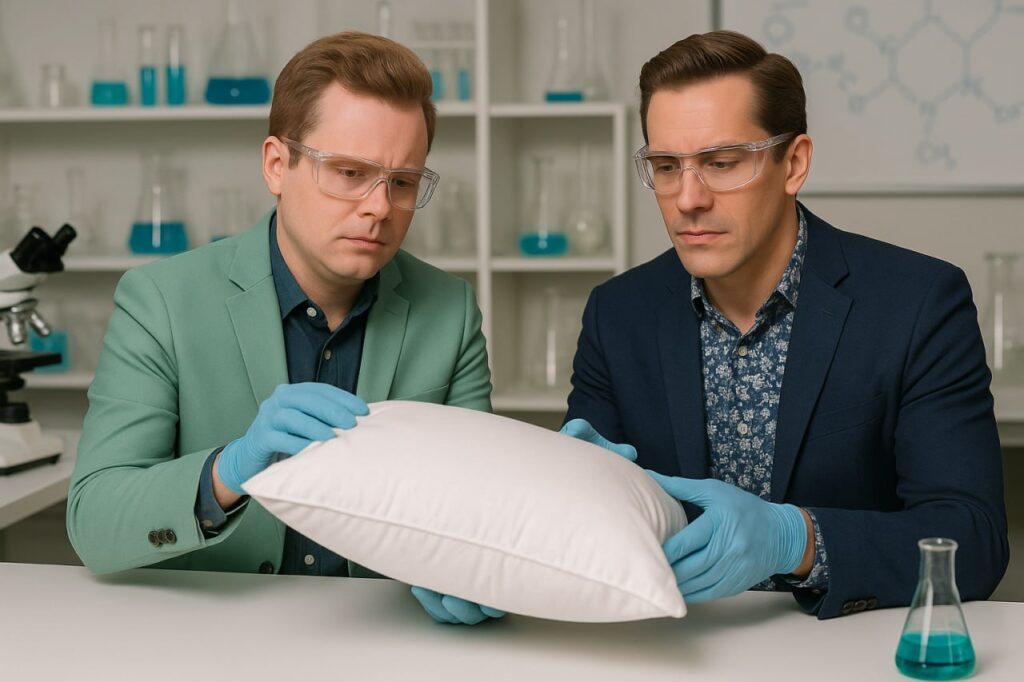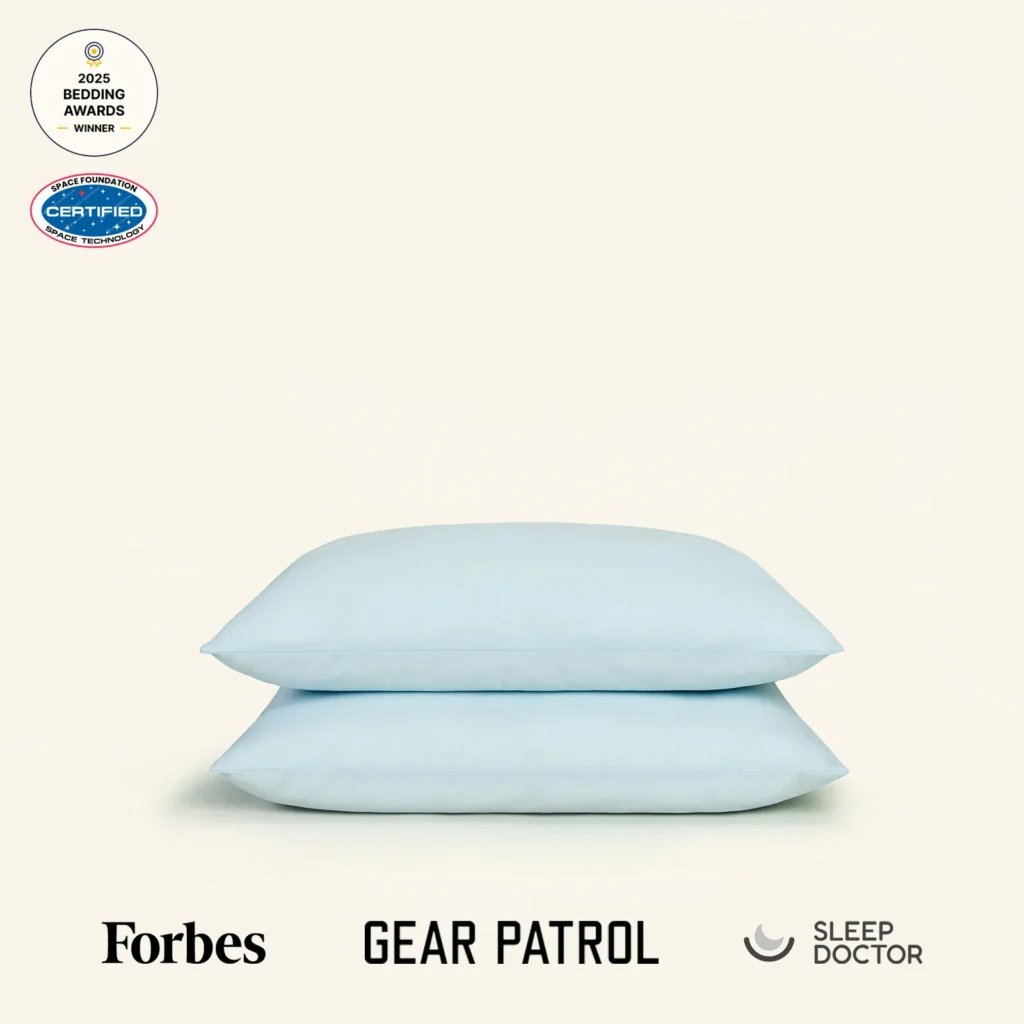They were used to solving problems in space. But when two former NASA engineers—Dr. Mark Jennings and Dr. Alan Monroe**—began struggling with something far closer to home, their lives took a surprising turn.
Both men had spent years developing materials for astronaut suits—specifically, phase-change fabrics designed to keep body temperatures stable in the harsh, fluctuating conditions of space. But back on Earth, neither of them could get through a night without tossing, overheating, and waking up exhausted.
“It didn’t make sense,” says Mark. “We could keep astronauts cool in orbit—but we couldn’t cool down our own pillows at home?”
That question led to an after-hours experiment that shocked their families—and the sleep science world.
Using NASA-developed temperature-regulating technology, Mark and Alan designed a pillow that senses body heat and automatically adjusts its surface temperature to stay consistently cool all night long.
It wasn’t just a little cooler—it was transformational.
The result became the Slumber Cloud UltraCool Pillow—now publicly available after years of private development.
Why It Works

The secret is in the Outlast® fabric, originally designed for NASA space suits. This material absorbs excess body heat when you’re too warm and releases it when you cool down—creating a perfectly balanced “thermal zone” around your head and neck.
✔️ **NASA-Engineered Cooling Fabric
✔️ No Flipping Needed—Always Feels Cool to the Touch
✔️ Premium Loft for Head & Neck Support
✔️ Hypoallergenic & Machine Washable
✔️ Clinically Inspired & Backed by Research
“It wasn’t built to sell a product,” says Alan. “It was built to solve our sleep problems.”
Their families noticed the change almost immediately: no more sweaty sheets, no more groggy mornings—just real, uninterrupted sleep and renewed morning energy.
But what surprised them most wasn’t just the pillow’s cooling ability—it was how many others shared the same problem. Mark explains, “Once friends, neighbors—even our own parents—tried it, they were converted.” That widespread response validated their intuition: this was not just a niche fix, but a universal need.
Today, the UltraCool Pillow is trusted by thousands—especially adults over 45 dealing with night sweats, hot flashes, or age‑related sleep changes. Users consistently report deeper sleep, fewer wake-ups, and relief from neck pain and morning stiffness—all from upgrading one element of their sleep setup: their pillow.
👉 Click here to try the NASA pillow everyone’s talking about
Medical & Scientific References

- Phase-change material (PCM) reduces skin temperature & improves sleep depth
In a 1996 study in Applied Human Science, subjects using a cooling pillow (with sodium sulfate + ceramic fiber) recorded significantly lower forehead and rectal temperatures during sleep and described deeper rest compared to a standard pillow ([spinoff.nasa.gov][1], [spinoff.nasa.gov][2], [springtextile.com][3], [gq.com][4], [verywellhealth.com][5], [sciencedirect.com][6], [jstage.jst.go.jp][7]). - PCMs stabilize skin temperature in bedding
Research on PCM mattresses found they better dissipate body heat within 20 minutes and provide greater thermal comfort than conventional designs ([sciencedirect.com][6], [tomsguide.com][8]). - PCMs in bedding reduce sweat production up to 48%
Outlast® temperature-regulating fabric has been shown to decrease sweat in cooling bedding by nearly half—supporting dryer, more restful sleep ([outlast.com][9]). - Appropriate pillow support improves neck pain & sleep quality
A randomized clinical trial in the Journal of Rheumatology (2007) found that a contoured neck-support pillow combined with therapeutic exercises significantly reduced neck pain versus control groups ([sciencedirect.com][10], [pubmed.ncbi.nlm.nih.gov][11]). - Review supports head-temperature-reducing pillows for sleep quality
A systematic review in Tjem/J‑Stage highlighted that pillows which help cool the head can reduce core temperature, lower heart rate, and promote deeper sleep cycles.
This blend of cutting-edge NASA tech and credible medical science makes the UltraCool Pillow not just innovative—but transformational.
- https://spinoff.nasa.gov/Spinoff2009/ch_4.html “Phase Change Fabrics Control Temperature | NASA Spinoff”
- https://spinoff.nasa.gov/Fixing_Thermal_Incompatibilties_in_the_Bedroom “Fixing ‘Thermal Incompatibilties’ in the Bedroom – NASA Spinoff”
- https://www.springtextile.com/blogs/pcm-cooling-bedding-the-future-of-temperature-regulated-sleep.html “PCM Cooling Bedding: The Future of Temperature-Regulated Sleep”
- https://www.gq.com/story/best-cooling-pillows “The Best Cooling Pillows You Never Have to Flip”
- https://www.verywellhealth.com/best-pillows-for-neck-pain-8721597 “The Best Pillows for Neck Pain, Tested and Reviewed”
- https://www.sciencedirect.com/science/article/abs/pii/S0894177716302941 “Assessment of a mattress with phase change materials using a …”
- https://www.jstage.jst.go.jp/article/ahs/15/4/15_4_155/_article/-char/en “Effects of Two kinds of Pillow on Thermoregulatory Responses …”
- https://www.tomsguide.com/mattresses/phase-change-material-vs-glaciotex “What are Phase Change Material and GlacioTex cooling mattress …”
- https://www.outlast.com/en/discover-outlast/news-events/phase-change-material “Phase Change Materials for Everyday Use | Outlast”
- https://www.sciencedirect.com/science/article/abs/pii/S0268003321000838 “Review The effects of pillow designs on neck pain, waking …”
- https://pubmed.ncbi.nlm.nih.gov/17216683 “Effect of therapeutic exercise and sleeping neck support on patients …”
- https://www.jstage.jst.go.jp/article/tjem/233/3/233_183/_html/-char/en “Improving the Quality of Sleep with an Optimal Pillow – J-Stage”

